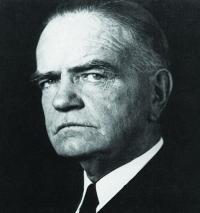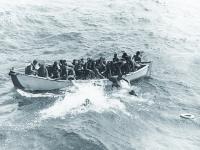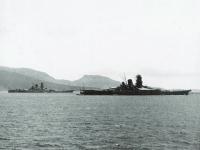Written By: Sam Ghaleb, Ridgecrest, Calif.

Adm. William F. (Bull) Halsey, Cmdr. US Third Fleet at Leyte Gulf.

USS Birmingham comes alongside the burning USS Princeton afire after Japanese air attack, 24 Oct. 1944.

Vice Adm. Thomas C. Kinkaid, USN, Cmdr. Seventh Fleet.

USS Reno comes alongside USS Princeton to help fight fires, 24 Oct. 1944.

Princeton survivors jumping from a motor whaleboat to swim to USS Casin Young, 24 Oct. 1044.

Twin Yamato class battleships Yamato and Musahi in anchorage. Each weighed 72,000 tons and carried 9 18-inch guns in 3 turrets.
THIS WEEK, seventy years ago, on October 23, 1944, the opening phase of the Battle of Leyte Gulf took place around the Philippine Islands. The Imperial Japanese Navy made its last determined effort to challenge the U.S. Navy and launched Operation SHO-1, the Japanese plan conceived to destroy the U.S. Naval units supporting the invasion forces. The goal of this operation was to stop General MacArthur from controlling the Philippine Islands. This plan was prepared by the Japanese several months before the actual U.S. landings on the Island of Leyte on October 20, 1944.
The defense of the Philippines was deemed crucial to the survival of the Japanese Empire. Without the Philippines all lines of communications would be cut and the essential supplies of oil from the Dutch East Indies (currently Indonesia), and raw materials from South East Asia would be lost. The Japanese command knew that if the Philippines were lost, then the war was also lost. They therefore drew up a desperate plan which risked their remaining surface forces, but offered them a remote chance of destroying the American invasion fleet and isolating the Allied ground forces on Leyte. Like many previous Japanese operational plans it was complex and depended on the use of a decoy force. The Japanese carriers at the time all lacked trained aircrews, and were therefore the warships selected to play the most important decoy role. The task of the Japanese carriers was to lure Admiral William F. Halsey's Third Fleet away, allowing Japanese warships to converge on, and destroy, the American ships supplying the invasion force.
The destruction of Japanese naval air power, in the Battle of the Philippine Sea, in June 1944, forced the Imperial Navy to prepare for a decisive battle using surface ships. The Imperial Navy's plan was to become effective when the U. S. Navy entered Philippine waters to invade and liberate that country. With the appearance of the U.S. landing forces, which included a force of more than 200 American and two Australian warships, off the Philippines on October 17, 1944, Admiral Soemu Toyoda, commander-in-chief of the Japanese Combined Fleet, placed the 68 ships in his four main strike groups on alert. When the American intention of landing on Leyte became clear, Toyoda ordered his units to execute the plan. Admiral Jisaburo Ozawa's carrier decoy, Northern Force, stationed in Japan, steamed out on October 20, as did Admiral Shoji Nishimura's Southern Force. Admiral Kiyohide Shima's Southern Force sailed on October 22. Admiral Takeo Kurita's powerful Center Force got underway on October 21. In all, the Imperial Japanese Navy assembled a fleet of one heavy carrier, three light carriers, nine battleships, 20 cruisers, and 35 destroyers. It was all that Japan had at the time in terms of carriers and major warships.
The line up of the U.S. Navy to defend the landing forces was entrusted to Admiral Halsey’s 3rd Fleet, which had the task of striking Japanese Combined Fleet warships. Task Force 38, where all the carriers and fast battleships were concentrated, was the striking fist of the 3rd Fleet. The main support force for the Allied invasion forces was Admiral Thomas Kinkaid’s 7th Fleet, which had the primary task to protect the landing beaches and lend support to the troops on the ground. Seventh Fleet was divided into a surface action force under Admiral Jesse Oldendorf, which was to block and engage any Japanese force trying to sneak through the Surigao Strait. A task force under Admiral Clifton Sprague, composed of small escort carriers (jeep carriers), screened by escort destroyers, was to defend the landing beaches. The total U.S. Naval forces included 16 fleet carriers, 18 escort carriers, 12 battleships, 24 cruisers, and more than 140 destroyers. There was one thing that complicated matters for the Allies - Halsey’s fleet came under Admiral Chester Nimitz’ Central Pacific Theater, while the Seventh Fleet came under General MacArthur’s Southwest Pacific Theater of Operations. There was thus no overall naval commander during the campaign, which almost led to great confusion in the forthcoming battle, and this nearly led to a strategic disaster for the Allies.
The Battle of Leyte Gulf included four decisive naval actions: the Battle of Sibuyan Sea on October 24; the Battle of Surigao Strait on October 24 and 25; the Battle off Samar on October 25; and the Battle off Cape Engano on October 25 and 26.
The Battle of Sibuyan Sea
The battle opened when the U.S. submarines Darter and Dace sank two of Admiral Kurita's heavy cruisers and severely damaged another. Before attacking, they radioed information concerning the Center Force. As the Japanese approached the Sibuyan Sea, Admiral Halsey, whose Third Fleet provided support for the Leyte operations, readied his carriers to strike. However, the Third Fleet suffered the first loss when land-based planes sank the light carrier Princeton on the morning of October 24. During the late morning and early afternoon, Task Force 38 made four air strikes on Kurita's ships, sinking the giant battleship Musashi and damaging a heavy cruiser. Kurita's advance became confused, and Admiral Halsey interpreted this confusion as retreat.
Battle of Surigao Strait
Seventh Fleet’s commander, Vice-Admiral Kinkaid, believing that Halsey protected his northern flank, prepared to intercept Nishimura's Southern Force. Although the Americans lost track of Nishimura's ships, it was obvious that their destination was Surigao Strait. Admiral Oldendorf arranged his ships, centered around six battleships that survived Pearl Harbor, in 1941, at the northern end of the strait. He placed PT boats along the southern end of the strait. Destroyers patrolled behind them waiting to launch torpedoes, and two groups of cruisers reinforced the battle line. Admiral Nishimura’s Southern Force proceeded toward Surigao Strait, unaware of the overwhelming force ahead. Admiral Shima with the rest of Southern Force steamed 40 miles to his rear.
The last great surface action of the 20th century lasted four hours. Nishimura bravely steamed ahead, while Admiral Oldendorf’s force crossed the T, a maneuver that allowed all U.S. battleships to fire simultaneously at the Japanese line. With U.S. PT boats and destroyers active in attacking the Japanese force, the result was near destruction by cruisers and battleships of the enemy’s ships. U.S. torpedoes and gunfire destroyed five of Nishimura's seven ships. As the Pearl Harbor battleships gained their revenge, Shima's seven ships entered the strait. The PTs again attacked and severely damaged a cruiser. The Southern Force of the Japanese was practically annihilated.
Battle of Cape Enganao
Admiral Halsey actually took the bait and took no steps to protect Seventh Fleet from the Japanese Center Force. Third Fleet left San Bernardino Strait entirely unguarded. His fixation with Japanese aircraft carriers was his weakness. Having located the Japanese carriers of the Northern Force - which Admiral Halsey regarded as both the main threat and the main prize - he decided to concentrate his three available carrier groups, with all their accompanying vessels, including the six fast battleships, steam northwards with all this force, and annihilate Ozawa's ships during daylight on October 25. The result was all of Ozawa’s carriers were sunk.
Battle off Samar Island
Admiral Kurita’s Center Force slipped through the unguarded San Bernardino Strait with a force that included four battleships, including the monstrous Yamato. It was an unequal battle. In a morning-long action on October 25, Admiral Sprague's force, assisted by the planes of his escort carriers, defended itself aggressively against the might of the Japanese Navy. Admiral Kurita, after inflicting some damage which resulted in the loss of an escort carrier, two destroyers, and one destroyer escort, decided to retreat. In the Battle off Samar, Center Force suffered five cruisers lost or severely damaged. Kurita overestimated the size of the U.S. force, and he also feared Halsey would cut off his line of withdrawal. After steaming aimlessly off Samar for several hours, Kurita retreated. In the aftermath to the surface action, the escort carriers were subjected to the first series of kamikaze attacks. On October 26, U.S. planes and submarines struck at the retreating Japanese forces and sank three Japanese transports.
The greatest naval battle the world had ever seen was over. The victory was overwhelming. At a cost of 12 ships; one light carrier, two escort carriers, two destroyers, two destroyer escorts, three submarines, one PT boat, and one fleet tug, the U. S. Navy sank 35 ships of the Imperial Japanese Navy, including one fleet carrier, three light carriers, three battleships, six heavy cruisers, four light cruisers, four submarines, 12 destroyers, one oiler, and one destroyer transport. The battle of Leyte Gulf ensured U.S. maritime supremacy in the last months of World War II. It had effectively eliminated the threat of Japanese warships to amphibious operations anywhere for the rest of World War Two, and it also ensured the isolation of Japan for the duration of the war.
NEXT WEEK:
COURLAND PENINSULA
«Go back to the previous page.





